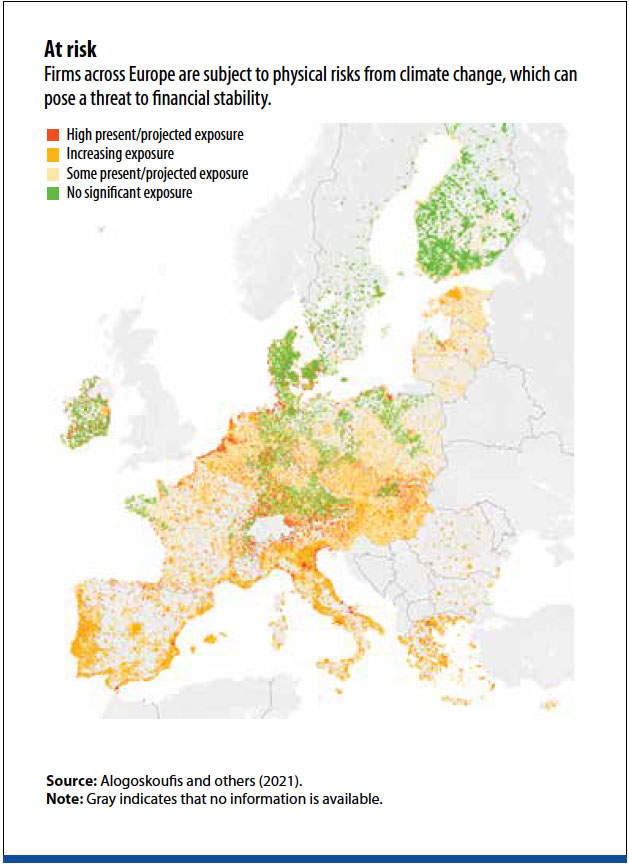Central banks must do their part in fighting global warming
The devastating effects of climate change are becoming increasingly evident. Temperature records are being shattered again this year—in Canada, the United States, arctic Russia, and central Asia. Globally, the past six years have been the hottest six on record, and temperatures in 2020 exceeded the 1850–1900 average by 1.25°C (2.25°F).
Exactly how climate change will affect the economy and the financial system is uncertain. The European Central Bank (ECB) is currently trying to quantify the consequences of climate change on companies and banks through an economy-wide stress test. The exercise, the results of which will be published soon, draws on a range of climate scenarios developed by the Network for Greening the Financial System (NGFS), a global association of central banks and supervisory authorities advocating a more sustainable financial system. These scenarios are used to assess the potential impact of climate change on roughly 4 million companies worldwide and nearly 2,000 banks in the euro area.
Preliminary results show that without further mitigation policies, physical risks from climate change—heat waves, windstorms, floods, droughts, and the like—will probably increase substantially (Alogoskoufis and others 2021). The average default probability of the credit portfolios of the 10 percent of euro area banks most vulnerable to climate risks could rise substantially—up 30 percent by 2050. Firms across Europe are exposed to physical risks from climate change, although risks are distributed unevenly (see chart).
Compared with these risks, the costs of transitioning to a carbon-neutral economy appear relatively contained (de Guindos 2021). There are clear benefits to acting early. The transition may be costly in the short run, but up-front investment will likely be more than offset over the long run as firms avoid the aggravation of physical risk and reap the economic rewards of mitigation. Based on a range of different models, recent IMF research echoes these findings (IMF 2020). The resulting message is simple: now is the time to undertake ambitious and broad-based action to ensure an orderly transition and mitigate the effects of climate change.
The existential threat posed by climate change implies that all policymakers must contemplate how to contribute to the fight against global warming. While governments are the primary actors, a consensus is building that central banks cannot stand on the sidelines. The NGFS, established with eight members in 2017, now has 95 members and 15 observers, including all major central banks. In 2019, the IMF joined as an observer.
The main reason central banks should increase their attention to climate change is the likelihood it will affect their ability to achieve their mandates. The ECB’s primary mandate is price stability, an objective shared by most central banks. Evidence suggests that climate change has crucial implications for price stability and also affects other areas of central bank competence, such as financial stability and banking supervision.
Climate change affects price stability through at least three channels.
First, the consequences of climate change might impair the transmission of central banks’ monetary policy measures to the financing conditions faced by households and firms, and hence to consumption and investment. Losses from materializing physical risks or stranded assets (such as oil reserves that will not be tapped as the world moves away from fossil fuels) could weigh on financial institutions’ balance sheets, reducing the flow of credit to the real economy. In addition, the longer climate change is insufficiently addressed, the greater the risks to policy transmission from a sharp and abrupt rise in credit risk premiums. Central banks themselves are exposed to potential losses—from securities acquired in asset purchase programs and on the collateral provided by counterparties in monetary policy operations.
Second, climate change could further diminish the space for conventional monetary policy by lowering the equilibrium real rate of interest, which balances savings and investment. For example, higher temperatures might impair labor productivity or increase rates of morbidity and mortality. Productive resources might be reallocated to support adaptation measures, while climate-related uncertainty may increase precautionary savings and reduce incentives to invest. Collectively, these factors can reduce the real equilibrium interest rate and therefore increase the likelihood that a central bank’s policy rate will be constrained. But this is far from certain; equilibrium rates might instead rise because of green innovation and investment and chart a path out of the current low-inflation, low-interest-rate environment.
Third, both climate change and policies to mitigate its effects can have a direct impact on inflation dynamics. Recent history confirms that a greater incidence of physical risk can cause short-term fluctuations in output and inflation that amplify longer-term macroeconomic volatility. Unless mitigation policies are more forceful, the risk of even larger climate shocks grows, with more persistent consequences for prices and wages. In addition, even mitigation policies, such as carbon pricing programs, can affect price stability, potentially precipitating large and long-lasting trends in relative prices and driving a wedge between headline and core measures of inflation.
As a result of these factors, central banks are starting to integrate climate-related risks into their monetary policy operations.
Opinions expressed in articles and other materials are those of the authors; they do not necessarily reflect IMF policy.
References:
Alogoskoufis, S. , and others. 2021. “Climate-Related Risks to Financial Stability.” Financial Stability Review, European Central Bank, Frankfurt.
de Guindos, L. 2021. “Shining a Light on Climate Risks: The ECB’s Economy-wide Climate Stress Test.” ECB Blog, March 18.
International Monetary Fund (IMF). 2020. “Mitigating Climate Change—Growth- and Distribution-Friendly Strategies.”“Mitigating climate change – growth- and distribution-
friendly strategies”, World Economic Outlook, Chapter 3, Washington, DC, October.
Papoutsi, M., M. Piazzesi, and M. Schneider. 2021. “How Unconventional Is Green Monetary Policy?” Stanford University working paper, Stanford, CA..
Schnabel, I. .2021., “From Market Neutrality to Market Efficiency.” Welcome address at the ECB DG-Research Symposium “Climate Change, Financial Markets and Green Growth.” Frankfurt, June 14.










